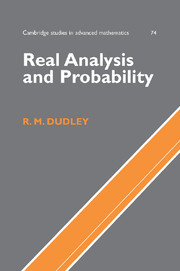Book contents
- Frontmatter
- Contents
- Preface to the Cambridge Edition
- 1 Foundations; Set Theory
- 2 General Topology
- 3 Measures
- 4 Integration
- 5 Lp Spaces; Introduction to Functional Analysis
- 6 Convex Sets and Duality of Normed Spaces
- 7 Measure, Topology, and Differentiation
- 8 Introduction to Probability Theory
- 9 Convergence of Laws and Central Limit Theorems
- 10 Conditional Expectations and Martingales
- 11 Convergence of Laws on Separable Metric Spaces
- 12 Stochastic Processes
- 13 Measurability: Borel Isomorphism and Analytic Sets
- Appendix A Axiomatic Set Theory
- Appendix B Complex Numbers, Vector Spaces, and Taylor's Theorem with Remainder
- Appendix C The Problem of Measure
- Appendix D Rearranging Sums of Nonnegative Terms
- Appendix E Pathologies of Compact Nonmetric Spaces
- Author Index
- Subject Index
- Notation Index
- References
1 - Foundations; Set Theory
Published online by Cambridge University Press: 06 July 2010
- Frontmatter
- Contents
- Preface to the Cambridge Edition
- 1 Foundations; Set Theory
- 2 General Topology
- 3 Measures
- 4 Integration
- 5 Lp Spaces; Introduction to Functional Analysis
- 6 Convex Sets and Duality of Normed Spaces
- 7 Measure, Topology, and Differentiation
- 8 Introduction to Probability Theory
- 9 Convergence of Laws and Central Limit Theorems
- 10 Conditional Expectations and Martingales
- 11 Convergence of Laws on Separable Metric Spaces
- 12 Stochastic Processes
- 13 Measurability: Borel Isomorphism and Analytic Sets
- Appendix A Axiomatic Set Theory
- Appendix B Complex Numbers, Vector Spaces, and Taylor's Theorem with Remainder
- Appendix C The Problem of Measure
- Appendix D Rearranging Sums of Nonnegative Terms
- Appendix E Pathologies of Compact Nonmetric Spaces
- Author Index
- Subject Index
- Notation Index
- References
Summary
In constructing a building, the builders may well use different techniques and materials to lay the foundation than they use in the rest of the building. Likewise, almost every field of mathematics can be built on a foundation of axiomatic set theory. This foundation is accepted by most logicians and mathematicians concerned with foundations, but only a minority of mathematicians have the time or inclination to learn axiomatic set theory in detail.
To make another analogy, higher-level computer languages and programs written in them are built on a foundation of computer hardware and systems programs. How much the people who write high-level programs need to know about the hardware and operating systems will depend on the problem at hand.
In modern real analysis, set-theoretic questions are somewhat more to the fore than they are in most work in algebra, complex analysis, geometry, and applied mathematics. A relatively recent line of development in real analysis, “nonstandard analysis,” allows, for example, positive numbers that are infinitely small but not zero. Nonstandard analysis depends even more heavily on the specifics of set theory than earlier developments in real analysis did.
This chapter will give only enough of an introduction to set theory to define some notation and concepts used in the rest of the book. In other words, this chapter presents mainly “naive” (as opposed to axiomatic) set theory.
- Type
- Chapter
- Information
- Real Analysis and Probability , pp. 1 - 23Publisher: Cambridge University PressPrint publication year: 2002



